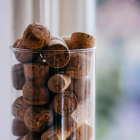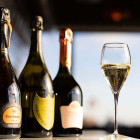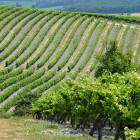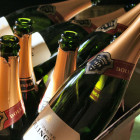New Release - Krug, Grande Cuvee Edition 168
Earlier this summer, Krug's non-vintage, or more aptly named “multi-vintage” Champagne was released by way of Zoom video to the wine trade. This is the 168th edition from Krug and is based on the highly rated 2012 vintage, but with 11 different vintages in total, including the iconic 1996 and from 198 separate wines!
This only goes to show the incredible work that goes into making a single bottle of Grand Cuvee, arguably more than their vintage champagne. New Chef de Cave (winemaker), Julie Cavil highlights that “you need 20-25 years to craft a bottle of Krug Grande Cuvée.”
Including vintages such as the 1996 in the final blend also shows that this is no ordinary “non-vintage”, and that this has the ageing ability of Grand Marques, vintage wines. William Kelley of the Wine Advocate recommended drinking windows are from now until 2040, this is very important as the majority of Grand Cuvee is drunk far too young putting huge stress on back vintages, which in turn drives price. Grand Cuvee Editions with 8 to 10 years+ in the market are incredibly hard to source in any kind of volume.
With portfolio resilience crucial at a time of broader market uncertainty, Champagne plays a defensive role with steady returns and low volatility, we therefore retained an overweight market view for Champagne and encourage all of our clients to add further exposure to this are of the market.
Key Points:
- £640 per 6x75cl (ex-fees)
- UK Market from £685 per 6x75cl
- 96 pts William Kelly (Wine Advocate)
- 19/20 Jancis Robinson (highest score to date)
- 2012 is the base vintage
- heralded as one of the greatest since the start of the century
- 198 different wines across 11 different vintages
- Oldest from the great vintage of 1996
- 7 years cellaring at Krug before release
- Each bottle has a unique identification code which allows owners to track information, such as disgorgement & final blends
- Older vintages are very hard to find on the secondary market as the Grand Cuvee is consumed far too early in its development
- Drinking Window: 2020 -2040+ (William Kelly WA)
- Back vintage benchmarks 6x75cl (Wine Searcher)
- Edition 160 - £1,200 +87.5%
- Edition 159 - £1,562 +144.1%
Tasting Notes:
Krug’s tasting note:
“At first sight, the wine has a light golden colour and fine, vivacious bubbles. On the nose are aromas of flowers in bloom, ripe, dried and citrus fruits as well as marzipan and gingerbread. The palate reveals flavours of hazelnut, nougat, barley sugar, jellied and citrus fruits, almonds, brioche and honey.”
William Kelley:
Krug's NV Grande Cuvée 168ème Édition is a classic in the making, wafting from the glass with aromas of dried fruits, pear, toasted nuts, orange zest, honeycomb and freshly baked bread. Medium to full-bodied, generous but incisive, it's deep and elegantly fleshy, with a beautifully refined mousse and an enveloping core of fruit that's complemented by the characteristic Krug patina of nutty complexity imparted by barrel fermentation. Even if this is more open out of the gates than the 2011-based 167ème edition, the 168ème edition is also the more concentrated and intense of the two. It's based on the 2012 harvest, complemented by fully 42% reserve wines—a blend of 198 wines from 11 different vintages dating back to 1996.
Jancis Robinson:
Notably intense aroma with crème pâtissière dominant. Masses of extract and remarkable acidity underpinned by great depth of flavour and beautiful balance on the finish. I think this is going to be a really great, glamorous Grande Cuvée that will continue to develop in bottle for many years to come. I suspect it will be even more enjoyable from the end of 2020. The length on the palate is remarkable. This is magnificently precise, a great tribute to the work of the old cellarmaster Eric Lebel, who is still in the background, and a wonderful welcome to his successor Julie Cavil, who has been learning from him since 2006.
A Brief History of Krug:
While Krug is now one of the world’s most famous luxury champagne houses, the brand’s history stems from much more humble roots. The House of Krug was founded in 1843 by Johann-Joseph Krug, a butcher’s son. Born in Mainz in 1800, Joseph (who dispensed with the name Johann) travelled to Paris in 1834 to work as an accountant for Champagne Jacquesson, in Chalons-sur-Marne.
It wasn’t long until Joseph’s work began taking him out of the office and around Europe where he learned about composition and taste, and he formed a much deeper interest in Champagne – and, it is said, an understanding that the essence of Champagne is pleasure itself. In 1843, after a year of negotiations, Krug et Cie was founded. That Joseph was fluent in several languages, including Russian, gave the company a key overseas advantage.
The business was passed down to Joseph’s son Paul – who has largely been credited for shaping the Krug company and its wines into what they are today – and then to Paul’s son Joseph II. From father to son the business has moved, every figure regarded as a popular and respected player in the Champagne industry, until 1962 when Henri Krug, son of Joseph II’s son Paul II, joined the management.
In January 1999 the House became part of the prestigious LVMH brand, but in keeping with the true family spirit of the company, Henri and brother Remi remained on the tasting committee, and in 2009 Henri’s son Olivier became House director.






